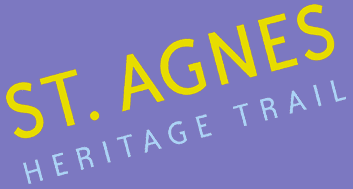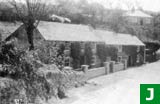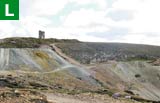
Walk 3 - Porthtowan, Banns Vale, Mount Hawke and Chapel Porth
 A few yards on we take the public footpath signposted on the right. We are now in Chapel Coombe
which is a quiet and gently sloping path, but there is evidence of mining with many shafts and there are
warning posts all around indicating spoil heaps on the hilltop. After you have passed the pumping
house of Charlotte United continue towards the sea until you reach the wide coastal path on the
left. If at this stage you are feeling a little thirsty or peckish or need a 'comfort stop' continue down to Chapel
Porth where you will usually find these facilities (somewhat improved since 1927); it is also a lovely spot
to stop for a 'breather'. But it now means you must retrace your steps back up to the path.
A few yards on we take the public footpath signposted on the right. We are now in Chapel Coombe
which is a quiet and gently sloping path, but there is evidence of mining with many shafts and there are
warning posts all around indicating spoil heaps on the hilltop. After you have passed the pumping
house of Charlotte United continue towards the sea until you reach the wide coastal path on the
left. If at this stage you are feeling a little thirsty or peckish or need a 'comfort stop' continue down to Chapel
Porth where you will usually find these facilities (somewhat improved since 1927); it is also a lovely spot
to stop for a 'breather'. But it now means you must retrace your steps back up to the path.
This wide track was built by American servicemen in June 1944 with a wooden bridge over the stream at the bottom.
 Great Wheal Charlotte L was once an important copper producing
mine and was opened (or reopened) in 1820 and rich copper ore
found. It is believed to have ceased working in the mid 1800s. The
one wall remaining is the large 'bob wall', on this wall the large
metal bob (or beam) pivoted. The inside end was connected to a
60 inch engine and the outside end to the wooden pump rod that
went down the shaft to pump the mine dry. It is worth taking the
detour on the left to see it closely before returning to the coast path.
As you are returning to Porthtowan do look directly ahead and on a
clear day you will
Great Wheal Charlotte L was once an important copper producing
mine and was opened (or reopened) in 1820 and rich copper ore
found. It is believed to have ceased working in the mid 1800s. The
one wall remaining is the large 'bob wall', on this wall the large
metal bob (or beam) pivoted. The inside end was connected to a
60 inch engine and the outside end to the wooden pump rod that
went down the shaft to pump the mine dry. It is worth taking the
detour on the left to see it closely before returning to the coast path.
As you are returning to Porthtowan do look directly ahead and on a
clear day you will  see Godrevy Point and St. Ives. Somewhat nearer,
you have a view of Porthtowan beach itself, it was here in 1998
that a 700lb leatherback turtle was found. The
leatherback is an endangered species
which feeds mainly on jellyfish, this
one later died, as it had
mistakenly swallowed a
discarded plastic bag, it
was believed to have
been about 80 years old and is
now preserved in the St Agnes Museum.
Continue to follow the coast path, which leads you back over the hill above Porthtowan to your
start but do watch your step as it can be rather rough in places.
see Godrevy Point and St. Ives. Somewhat nearer,
you have a view of Porthtowan beach itself, it was here in 1998
that a 700lb leatherback turtle was found. The
leatherback is an endangered species
which feeds mainly on jellyfish, this
one later died, as it had
mistakenly swallowed a
discarded plastic bag, it
was believed to have
been about 80 years old and is
now preserved in the St Agnes Museum.
Continue to follow the coast path, which leads you back over the hill above Porthtowan to your
start but do watch your step as it can be rather rough in places.
 Walk 1 - St.Agnes Village Trail
Walk 1 - St.Agnes Village Trail Walk 2 - St Agnes Beacon
Walk 2 - St Agnes Beacon Walk 3 - Porthtowan, Banns Vale, Mount Hawke and Chapel Porth
Walk 3 - Porthtowan, Banns Vale, Mount Hawke and Chapel Porth Walk 4 - Wheal Rose, The Poldice Plateway and Mawla
Walk 4 - Wheal Rose, The Poldice Plateway and Mawla Walk 5 - Mount Hawke
Walk 5 - Mount Hawke Walk 6 - Mithian
Walk 6 - Mithian Walk 7 - Wheal Coates, Chapel Porth, Wheal Lawrence Valley and Goonvrea
Walk 7 - Wheal Coates, Chapel Porth, Wheal Lawrence Valley and Goonvrea Walk 8 - Water Lane, Wheal Butson and Jericho Valley
Walk 8 - Water Lane, Wheal Butson and Jericho Valley Walk 9 - Jericho Valley and Cross Coombe
Walk 9 - Jericho Valley and Cross Coombe Walk 10 - Blackwater
Walk 10 - Blackwater
